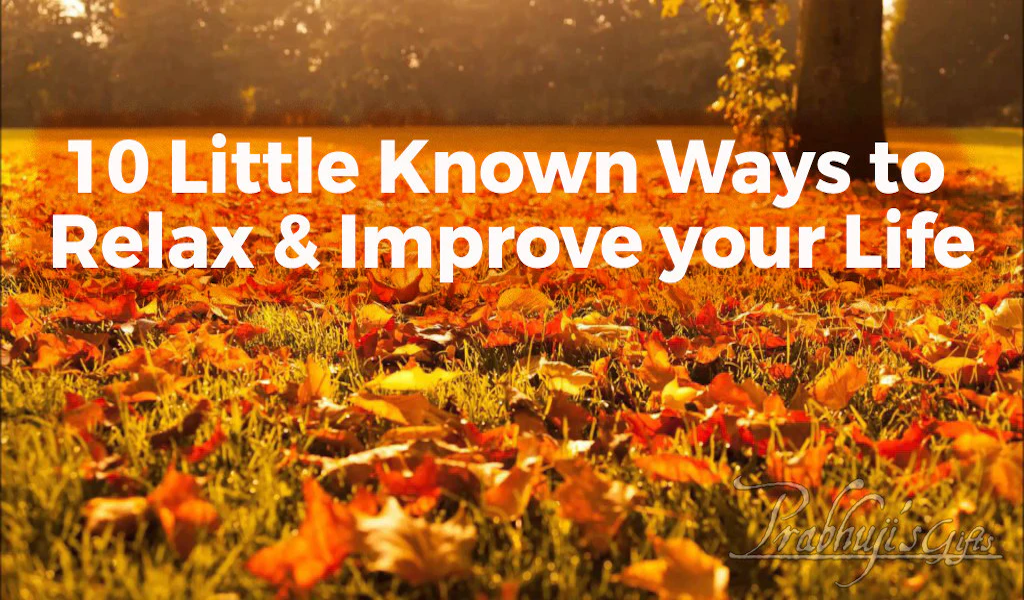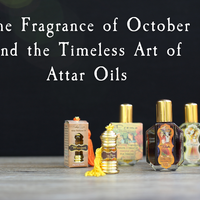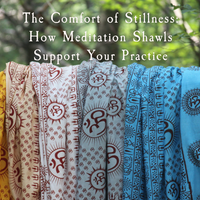Bye-bye tension, hello tranquility

-
Corpse pose
 We know, we know, it doesn’t sound too promising, but trust us, it’s ingenious. The original name for this yogic practice is shavasana, a Sanskrit word that means “corpse pose” as the posture requires you to lie down and be completely still. The surprise here, and challenge for many, is that it also involves remaining completely aware, rather than falling asleep. To start, lie on your back with your legs apart and your arms away from your body, palms up (slightly resembling Leonardo da Vinci’s Vitruvian Man except that the arms shouldn’t be that far from your torso). Point your toes, tighten every muscle in your legs and raise them just 1 inch above the floor for a moment, and then let them drop, completely relaxed. Make fists, tighten every muscle in your arms and raise them 1 inch above the floor for a moment, and drop. Contract your buttocks, raise your hips up for a moment, and then relax. Raise your head, open your eyes wide, open your mouth and stick your tongue out as far as you can. Hold this for a moment, and then relax down. Now, one by one, bring your awareness to each part of your body, starting with your toes and working your way up to the crown of your head. Take your time. Don’t forget the little-remembered parts of your body as well, such as your internal organs, tongue and eyelids. Feel the weight of your body sinking toward the earth. Observe how the air enters your nostrils with each inhalation and exits with each exhalation. After completely relaxing your body, continue to lie there and observe this physical relaxation with awareness. After 10 minutes, take three deep and slow breaths, slowly rotate your hands and feet, and let your head fall gently from side to side. Raise your arms over your head and bring your legs together. Stretch from the tips of your toes to the tips of your fingers.
We know, we know, it doesn’t sound too promising, but trust us, it’s ingenious. The original name for this yogic practice is shavasana, a Sanskrit word that means “corpse pose” as the posture requires you to lie down and be completely still. The surprise here, and challenge for many, is that it also involves remaining completely aware, rather than falling asleep. To start, lie on your back with your legs apart and your arms away from your body, palms up (slightly resembling Leonardo da Vinci’s Vitruvian Man except that the arms shouldn’t be that far from your torso). Point your toes, tighten every muscle in your legs and raise them just 1 inch above the floor for a moment, and then let them drop, completely relaxed. Make fists, tighten every muscle in your arms and raise them 1 inch above the floor for a moment, and drop. Contract your buttocks, raise your hips up for a moment, and then relax. Raise your head, open your eyes wide, open your mouth and stick your tongue out as far as you can. Hold this for a moment, and then relax down. Now, one by one, bring your awareness to each part of your body, starting with your toes and working your way up to the crown of your head. Take your time. Don’t forget the little-remembered parts of your body as well, such as your internal organs, tongue and eyelids. Feel the weight of your body sinking toward the earth. Observe how the air enters your nostrils with each inhalation and exits with each exhalation. After completely relaxing your body, continue to lie there and observe this physical relaxation with awareness. After 10 minutes, take three deep and slow breaths, slowly rotate your hands and feet, and let your head fall gently from side to side. Raise your arms over your head and bring your legs together. Stretch from the tips of your toes to the tips of your fingers.
-
Have a good belly laugh
 You have to admit that it’s hard to feel bad while laughing, even if you have to force the laughter at first. The easiest way to do this is with at least one other person because, let’s face it, it’s just really funny to watch someone else laughing or at least making faces and trying to laugh. Think back to the last time you had a whole-hearted belly laugh and try to remember what you were thinking. If you’re like us, you were only thinking one thing at that time, and that was what was so darn funny. Any stress was, at least for that moment and a while afterward, completely forgotten. And after the rollicking laugh, we’re sure that you felt pretty darn relaxed, maybe even like a weight fell off your shoulders. If this isn’t enough to convince you to get a good chuckle going, maybe the physical benefits will. Laughing gets you inhaling more oxygen, stimulates your heart, lungs and muscles, and increases your feel-good hormones, a.k.a. endorphins. But it’s not all about short-term benefits. All the positivity that comes with laughter can actually improve your general mood and help you fight stress as it releases neuropeptides, making it easier to deal with difficult situations that life often throws our way.
You have to admit that it’s hard to feel bad while laughing, even if you have to force the laughter at first. The easiest way to do this is with at least one other person because, let’s face it, it’s just really funny to watch someone else laughing or at least making faces and trying to laugh. Think back to the last time you had a whole-hearted belly laugh and try to remember what you were thinking. If you’re like us, you were only thinking one thing at that time, and that was what was so darn funny. Any stress was, at least for that moment and a while afterward, completely forgotten. And after the rollicking laugh, we’re sure that you felt pretty darn relaxed, maybe even like a weight fell off your shoulders. If this isn’t enough to convince you to get a good chuckle going, maybe the physical benefits will. Laughing gets you inhaling more oxygen, stimulates your heart, lungs and muscles, and increases your feel-good hormones, a.k.a. endorphins. But it’s not all about short-term benefits. All the positivity that comes with laughter can actually improve your general mood and help you fight stress as it releases neuropeptides, making it easier to deal with difficult situations that life often throws our way.
-
Let Mother Nature share her serenity
What do trees, plants, mountains and bodies of water have in common? Their energetic vibrations are in tune with existence, with the universal consciousness. Most of us humans, on the other hand, are distracted by personal desires, attachments and other disturbances that create stress and other unpleasantries. This makes Mother Nature a great source of relaxation. She grounds us, brings us back to basics. All we have to do is envelope ourselves with her, whether it be by going for a gentle walk in the forest, a challenging hike in the mountains, or sitting still near a lake, river or ocean. Spending time surrounded by nature is a sure fire way to relax. There are also many who see God in the different aspects of nature, bringing us comfort, gratitude and awe.
-
Consider the gunas
 A guna is a material mode of nature and our actions are ruled by them. There are three gunas: sattva is associated with purity and goodness, and is the superior guna; rajas is activity and passion; and tamas is inertia, ignorance and laziness. Everyone has a dominant guna, which may change according to circumstances. Spiritual aspirants actually aim to transcend all three of these, which is no easy accomplishment, but in the meantime, the mode of sattva as the most sought after as it is in this mode that a more peaceful existence becomes possible. Making sattva your dominant guna can be done in a number of ways, including eating sattvic food, listening to sattvic music, surrounding yourself by sattvic aromas and exposing yourself to sattvic experiences, rather than rajasic or tamasic. Sattvic food includes grains, beans, certain vegetables, fruit and nuts. Meat, on the other hand, is tamasic, which is not to be confused with relaxation but rather a force that promotes darkness and resistance. Sattvic foods are filled with prana, which is a vital energy. Sattvic aromas include frankincense, lavender, sandalwood, rose and ylang ylang.
A guna is a material mode of nature and our actions are ruled by them. There are three gunas: sattva is associated with purity and goodness, and is the superior guna; rajas is activity and passion; and tamas is inertia, ignorance and laziness. Everyone has a dominant guna, which may change according to circumstances. Spiritual aspirants actually aim to transcend all three of these, which is no easy accomplishment, but in the meantime, the mode of sattva as the most sought after as it is in this mode that a more peaceful existence becomes possible. Making sattva your dominant guna can be done in a number of ways, including eating sattvic food, listening to sattvic music, surrounding yourself by sattvic aromas and exposing yourself to sattvic experiences, rather than rajasic or tamasic. Sattvic food includes grains, beans, certain vegetables, fruit and nuts. Meat, on the other hand, is tamasic, which is not to be confused with relaxation but rather a force that promotes darkness and resistance. Sattvic foods are filled with prana, which is a vital energy. Sattvic aromas include frankincense, lavender, sandalwood, rose and ylang ylang.
-
Breathing exercises
There is a yogic exercise called pranayama, which is a set of different breathing exercises that don’t only expand the vital energy (prana) in your body and make you feel unbelievably great, but also calm the mind. If you can influence prana through breathing, you can improve your emotional state. The magic with pranayama with regards to relaxation is that when you’re focused on your breath, idle and distracting thoughts disappear and the mind naturally calms down. Any session of pranayama is followed by tranquility and a boost of energy.
-
Let the good vibes flow Bad vibes can be exhausting and disturbing so if you want to relax, you need to shoo them out the door. We’re all aware, to varying degrees, of different energies and if there’s a negative vibe in the air, relaxation is next to impossible. Fortunately there’s a remarkably simple way to lighten the mood and attract the good stuff to aid your relaxation. First clear out any negative energy from your home by safely burning sage or Palo Santo wood, as Native Americans have been doing for centuries. The bitter smoke purifies the air and you’ll feel the difference instantly. Next, attract positive energy by burning sweet grass or incense. Don’t forget to keep it safe!
-
Aromatherapy
 While the scent of certain herbs, aromatic woods and resins raise our energy level and act as aphrodisiacs, others have the inherent ability to help us relax. Some are enjoyed in the form of essential oils that are either worn as a perfume or burned in an oil diffuser in order to fill the air at home. Others, like frankincense and sandalwood, can be burned in the same way they’ve been used for thousands of years, letting the aromatic smoke dance into every nook of your room while you gently inhale and let your tension fall away. Other oils, resins and dried herbs reputed for inducing relaxation are: bergamot, chamomile, geranium, lavender, neroli, petitgrain, rose, ylang ylang, benzoin, cedarwood, clary sage, jasmine and patchouli.
While the scent of certain herbs, aromatic woods and resins raise our energy level and act as aphrodisiacs, others have the inherent ability to help us relax. Some are enjoyed in the form of essential oils that are either worn as a perfume or burned in an oil diffuser in order to fill the air at home. Others, like frankincense and sandalwood, can be burned in the same way they’ve been used for thousands of years, letting the aromatic smoke dance into every nook of your room while you gently inhale and let your tension fall away. Other oils, resins and dried herbs reputed for inducing relaxation are: bergamot, chamomile, geranium, lavender, neroli, petitgrain, rose, ylang ylang, benzoin, cedarwood, clary sage, jasmine and patchouli.
- Hatha Yoga This is the physical yogic practice, most commonly referred to simply as “yoga” in the West. It’s a series of physical postures called asanas and is actually meant to be done in a relaxed state. But don’t worry. If you don’t start out relaxed, you certainly will finish the session that way if you do each and every move with awareness. This ancient technique is actually a spiritual practice and form of meditation. But while many find it difficult to stop their thoughts in meditation, hatha yoga starts at a point that we can perceive through our senses—the physical body. When done properly with relaxation, yoga makes the body feel great while calming the mind as it brings us to the here and now.
-
Meditatation
 This may be a tall order if you’re in the depths of stressdom, but it’s an invaluable practice with unbelievable rewards. Find a quiet place and sit comfortably on a pillow on the floor, rest the back of your hands on your knees and sit with a straight back, elongating up through the top of your head while pressing down toward the earth with your tailbone. Bring your awareness to the weight of your body on the pillow and relax that area. Bring your awareness to your legs and relax them. Feel your hands resting on your knees and relax. Bring your awareness to each part of your body in this way, from your lower extremities moving higher, and relax. Burn incense if it inspires you. Now meditate, and by meditate we mean do nothing at all. Just be. Observe yourself internally and watch how you become less identified with your thoughts. Over time and with steady practice, you will identify less and less with your own mental activity until it eventually ceases. You are now on track for the glorious state of no thoughts, no desires, but plenty of bliss.
This may be a tall order if you’re in the depths of stressdom, but it’s an invaluable practice with unbelievable rewards. Find a quiet place and sit comfortably on a pillow on the floor, rest the back of your hands on your knees and sit with a straight back, elongating up through the top of your head while pressing down toward the earth with your tailbone. Bring your awareness to the weight of your body on the pillow and relax that area. Bring your awareness to your legs and relax them. Feel your hands resting on your knees and relax. Bring your awareness to each part of your body in this way, from your lower extremities moving higher, and relax. Burn incense if it inspires you. Now meditate, and by meditate we mean do nothing at all. Just be. Observe yourself internally and watch how you become less identified with your thoughts. Over time and with steady practice, you will identify less and less with your own mental activity until it eventually ceases. You are now on track for the glorious state of no thoughts, no desires, but plenty of bliss.
- Mindfulness This is a specific type of meditation that comes from Buddhism and has evolved into therapeutic techniques in clinical psychology and psychiatry here in the West. Mindfulness has been discovered to reduce anxiety and stress, and as a way to get emotions under control. To practice mindfulness, go to a quiet and secluded place where you can relax without any distractions, and sit comfortably. Now you need a focal point, such as the flame of a candle, or something else that is positive and within your view. If you are more drawn to an internal focal point, close your eyes and focus on a feeling, imaginary scene or a mantra that you will repeat. Now, just observe. Let any self-criticism fall by the wayside. Let any distracting thoughts drift away like an autumn leaf flowing downstream and return your attention to your point of focus.









0 comments